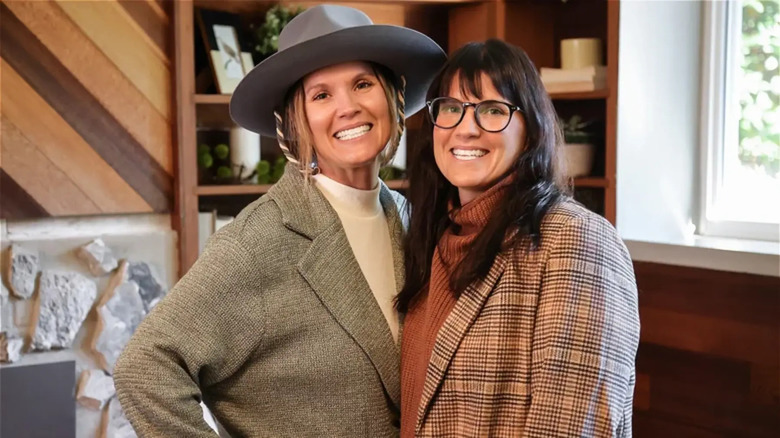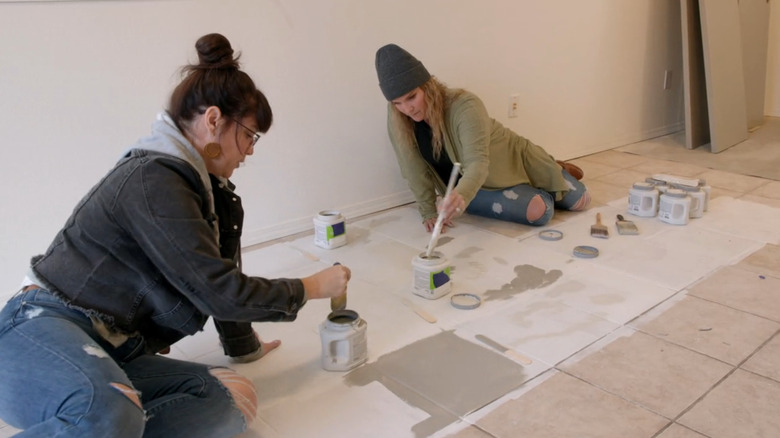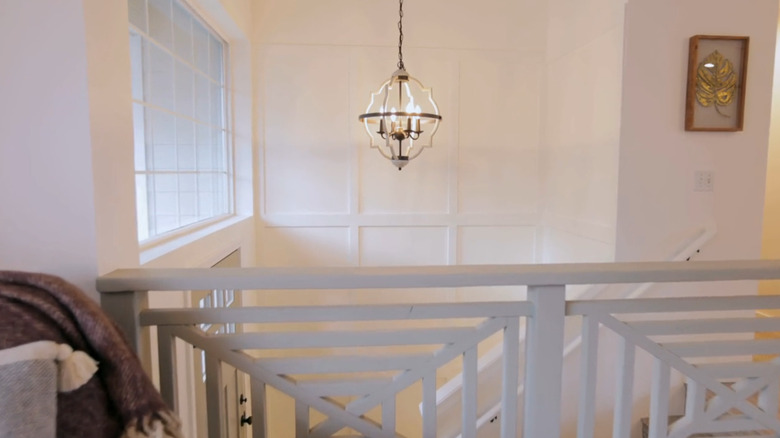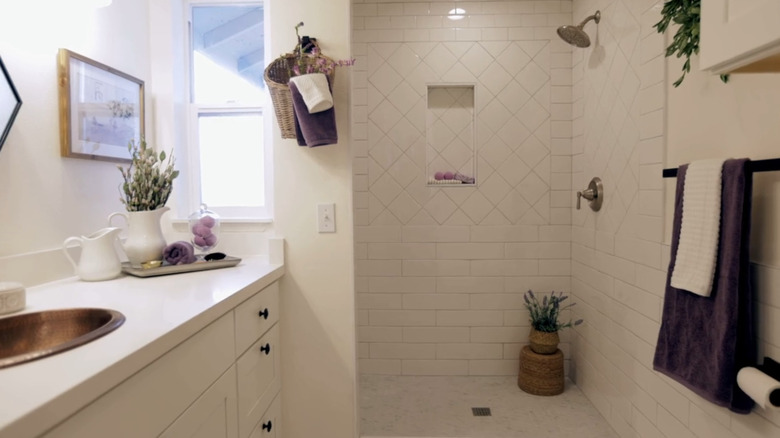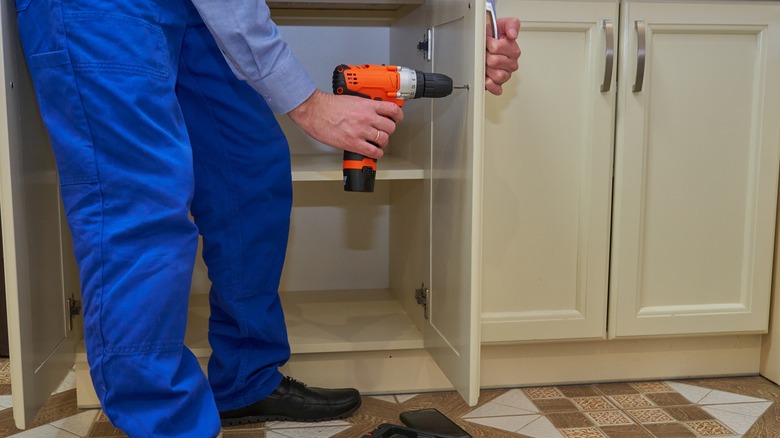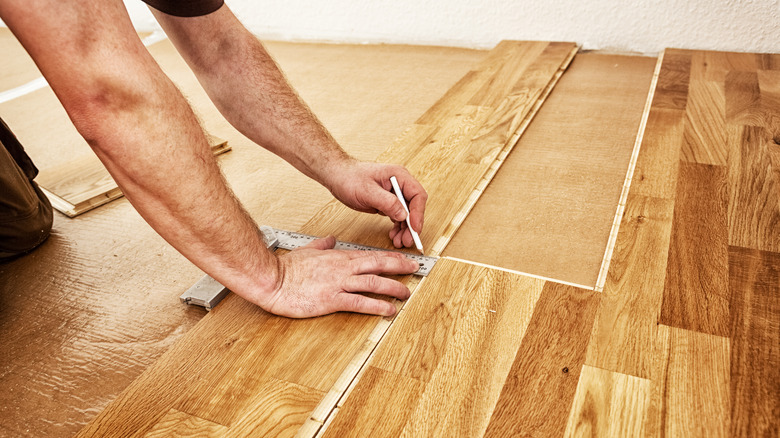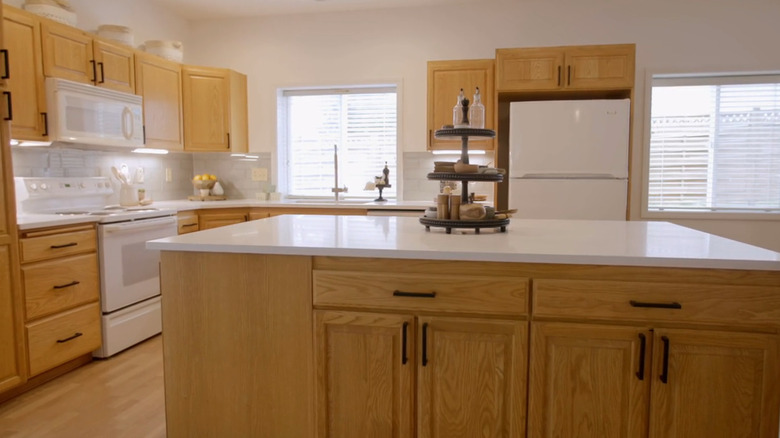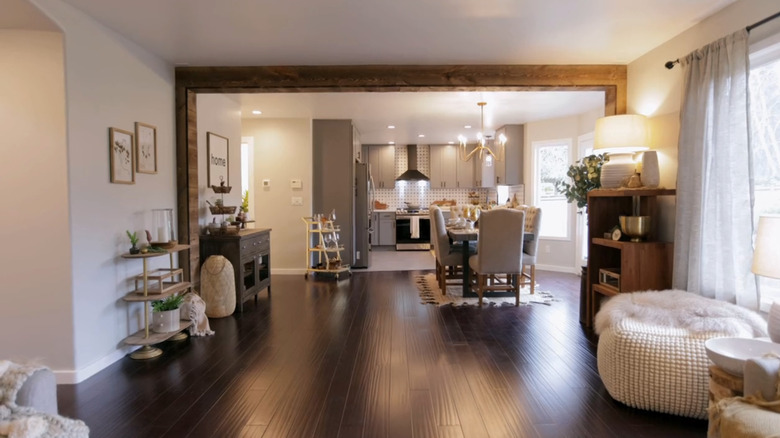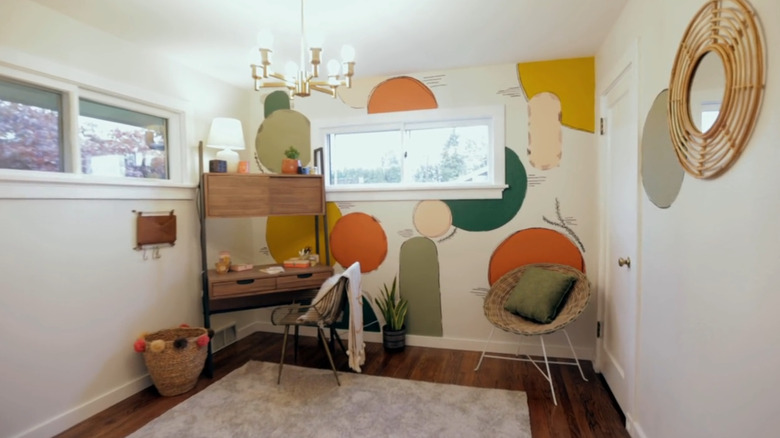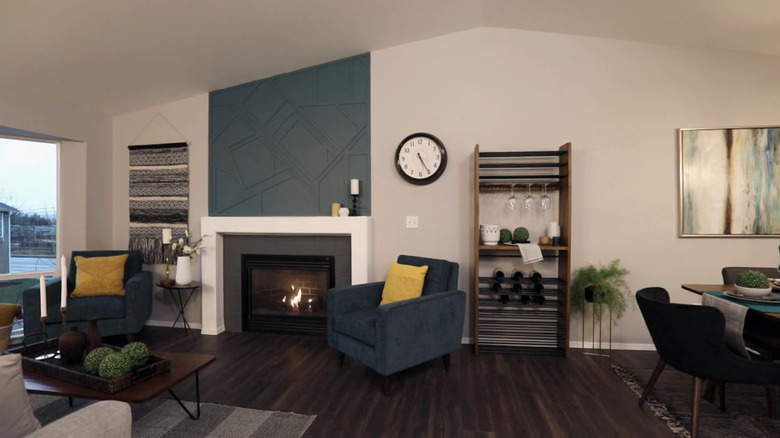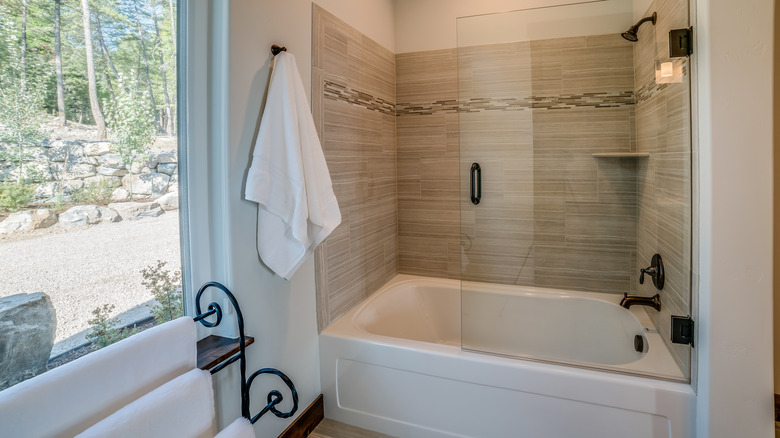The Stars Of Unsellable Houses' 11 Best Budget-Friendly Renovation Tips
We may receive a commission on purchases made from links.
The stars of "Unsellable Houses," twin sisters Leslie Davis and Lyndsay Lamb, aren't just HGTV hosts. They're also tycoon real estate agents, selling an average of 170 homes per year. Not only do they sell properties, but they also flip them, so they know a thing or two about renovating homes on a budget. In their TV show, they help struggling clients flip their homes with their bottom dollar in mind, transforming outdated spaces into modern houses that buyers will clamber to buy. But, even if you don't plan to sell your home anytime soon, you can still learn a thing or two about how to renovate your space on a budget.
Their tips can help you upgrade certain drab areas without straining your budget or help you give them a minor facelift before you can invest more funds into a thorough renovation. These tips tackle both big and small projects, giving even the most timid DIYer some inspiration. From how to save money on retiling your shower to injecting some interest into an uninspired room with just a little bit of paint, they're sure to make your house feel refreshed. Take a look at some of Leslie and Lyndsay's best tips below.
Cut down costs by painting tile instead of replacing it
When you dislike your tile, the idea of a complete gut job is tempting. However, if you're working with a limited budget, investing in such a project can quickly deplete your funds. A more economical choice is to paint your tiles. "Ripping out tile is so expensive. It's easy to damage the subfloor under tile. Painting it is absolutely the easiest and most cost-effective way to go," Lamb said in Season 2, Episode 6, sharing how they updated a dowdy den. They invested about $200 in paint to transform the floor from beige to cream tile, saving hundreds if not thousands of dollars.
To do it in your own space, Lamb recommends looking at All Things Trifty's tutorial on how to go about doing it. First, clean the flooring with Krud Kutter to ensure there isn't any dirt or residue. If there is, it will get trapped underneath the paint and create an uneven surface. It also won't look like real tile since you will see the texture. Once dry from the cleaning, paint the tile with a nap paint roller using Rust-Oleum Home Floor Coating Base Coat. Allow it to dry for a day, and paint a second layer. Lastly, seal the flooring with Rust-Oleum Matte Clear Interior Floor Topcoat to ensure the floor color stays intact and doesn't get easily chipped or scratched.
Add board and batten to elevate rooms
If you have an area of your house that seems dated or clunky — such as a cramped entryway in a split-level floorplan – you can easily transform it by adding a memorable architectural accent, such as board and batten. That's exactly what Lamb and Davis did in Season 2, Episode 6. "When we take on a split-level, we always try to come up with ways to focus on the design aspects to bring more of an appeal to that entryway," Davis said in the episode. "Board and batten is actually a really cool technique of putting plywood on a wall to give it that nice flat surface, and then using trim pieces to trim it out into boxes." The recurring pattern creates an elegant finish, adding interest to a place that might have felt uninspired before.
To install board and batten yourself, all you will need are some MDF boards and a nail gun. You will need 1 inch by 4 inch boards for your horizontal pieces and 1 inch by 3 inch boards for your vertical pieces. If you don't have a saw to cut the MDF board, you can ask hardware stores like Home Depot to make the cuts for you for a small fee. Once you have your supplies, remove your room's baseboards and begin to nail your boards into your chosen design with 2 inch nails. The height of the wainscoting is a personal choice, but you usually want it to take up ⅓ of the wall.
Mix and match tiles from past projects to save money
If you have done your fair share of tiling projects in the past, then you likely have a surplus of tiles left over. Put those to use by mixing and matching them to update your bathroom rather than buying a new set of matching tiles. This can save you some major dough. In Season 2, Episode 6, Davis updated Jeff Laurence, their contractor, on how she wanted to save money on their bathroom remodel. "I brought extras that we have left over from jobs that we've done with you," she said in the episode. She brought out several boxes of varying sizes of white tile, to which Laurence answered, "Then we have to mix them."
You can create several designs with mix-and-match tiles. For example, you can fashion decorative bands if you have varying sizes, and can make a contrasting nook if you have some that are in opposing colors or patterns. That's what Laurence did, and the end result looked polished and intentional. You can play around with the configurations on the floor first to see which design you like the most before committing to installing it on the wall. If you don't have leftover tile but still want to utilize this tip, consider searching on Facebook Marketplace. People who have leftover supplies from their home reno projects post their surplus on reselling apps to recoup some of their costs, and you can take advantage of the steep discount.
Replace cabinet doors rather than scrapping the entire cabinet system:
If you have an outdated kitchen, it can seem tempting to gut the entire room and start fresh. But, investing in a new cabinet system can cost you thousands of dollars. Some might opt to paint the doors to give them new life, but sometimes the door design is old-fashioned and can't be saved. If you don't have room in your budget to upgrade the entire system, then Lyndsay Lamb and Leslie Davis suggest keeping the cabinet boxes and swapping out the doors instead. It can help you save big bucks when renovating your kitchen. "If you need more than just paint to make it feel right, you can still save a ton by just replacing the doors to a new style and leaving the cabinet body in place," they told House Beautiful. This will give you a completely new look for a fraction of the price.
To utilize this tip, consider getting doors from a wholesaler, such as Fast Cabinet Doors or The Cabinet Door Store. You can choose between hardwood or MDF, browse through different wood species, pick untreated wood you can stain yourself, select pre-painted or stained doors, and even select your preferred hinges. If you have a few cabinets that aren't a standard size, these sites also offer custom options, allowing you to get exactly what you need to finish your remodel.
Look for supplies on Facebook Marketplace or Craigslist
Whether you're trying to wallpaper a powder room or install a new backsplash in your kitchen, you can save a good amount of change if you buy those supplies secondhand rather than retail. And it's not just supplies — you can also snag great deals on things like washing machines and fridges, too. "People are always moving and need to sell perfectly fine appliances quickly, or you may end up finding a ton of lumber left over from someone else's project they need to sell before moving," Lamb and Davis told House Beautiful. They recommended the same tip on a news segment on KUTV Fresh Living, sharing, "OfferUp, Facebook Marketplace — go on alternative sites where maybe somebody overbought and has that leftover material that you can take advantage of if it's the right amount for you." Their miscalculation is your gain.
To successfully look for supplies, you need to start the hunt early and look often. It will be rare to find exactly what you're looking for on the first try. You can set alerts for keyword searches on platforms like OfferUp and Facebook Marketplace, which will send you a push notification every time a new listing has been posted. For example, if you need marble tile for your bathroom floor, set alerts for multiple keywords like "marble floor tile," "marble tile," or "white tile." You want to try varied searches since not everyone is detailed or specific in their ads.
Use engineered hardwood over real hardwood
While there are many vinyl or tile floor brands that can imitate the appearance of wood, they often fall short in texture. They just don't feel like hardwood underfoot. However, investing in real wood flooring can cost thousands — if not tens of thousands — of dollars, depending on the area you need to cover. To avoid taking such a chunk out of your budget, Lyndsay Lamb and Leslie Davis suggest using engineered hardwood. "Engineered hardwood is not only budget-friendly but also much easier to install compared to traditional wood (and our contractors really thanked us for that!)," Lamb wrote in a blog post. "With engineered hardwood, there was no need for sanding, staining, or sealing, and it's lightweight!"
There are a couple of major benefits of engineered hardwood. Not only is it less expensive than natural hardwood, but it's much easier to install thanks to its click-lock feature. Each plank has a tongue and a groove, and they interlock together to create a floating floor. This negates the need for glue or nails, saving you money on supplies. It's also easy to DIY, so you won't need to hire out the project. Plus, since the boards are already prefabricated to a certain color or stain, you won't need to invest in cans of stain or sealer, saving you a lot of money.
Keep your old cabinets, but update the countertop and backsplash
Cabinets are one of the most expensive elements during a remodel. On average, homeowners shell out $8,200 to revamp their space with new cabinets, which can take a large chunk out of your remodeling budget. To avoid that, Lyndsay Lamb and Leslie Davis suggest leaving the outdated cabinets but modernizing them with a new countertop and backsplash. "We needed to be smart with our budget, and designing a new kitchen downstairs did not make sense. Instead, we kept the original cabinets, adding a new backsplash and quartz countertops," Lamb shared in a blog post referencing a '90s kitchen from Season 3, Episode 11. It had orange oak wood cabinets, but the sisters made them feel more contemporary by surrounding them with modern tiles and stone. They echoed this same tip on a segment on KUTV Fresh Living, explaining, "Try something like the backsplash. It's a quarter of the cost and it can transform the entire kitchen."
If you don't have the funds to replace both at the same time, consider doing a peel-and-stick tile for the backsplash until you're ready for a more permanent update. These are usually made from vinyl and have an adhesive backing you can stick right on top of the existing tile, negating the need for demo or mortar. You can find attractive, believable options from brands like Smart Tiles, which carry everything from classic subway tiles to trendier zellige tile.
Brighten dark floors without replacing them
Some people love dark floors, but they tend to make a room look smaller and heavier, especially if the space doesn't get a lot of natural light. However, replacing them can cost a pretty penny. If it's not in your budget, Leslie Davis and Lyndsay Lamb suggest brightening them with the power of design. "In all honesty, I really wanted to replace the dark hardwood flooring in the home to brighten up the space, but it just wasn't in the budget. Instead, I got really intentional about adding canned lights in the main living areas, using light paint on the walls, and staging with furniture and decor that made the home feel open and bright," Lamb wrote in a blog post about Season 2, Episode 11. By adding more lighting and contrasting the dark wood with lots of white features, the house managed to feel airy rather than heavy.
If you can't install more recessed lights into your ceiling, another workaround is to add more floor lamps, table lamps, and sconces. For sconces, you can get versions that plug into outlets, or get hardwired ones but install rechargeable lightbulbs or puck lights into the sockets. This negates hardwiring. Rechargeable bulbs, such as the DABAOLUM bulbs on Amazon, are initially charged in a lamp plugged into the wall, but then can be moved into a sconce. Puck lights, such as the Brilliant Evolution Store lights on Amazon, are battery-operated and can be turned on and off with a remote.
Create interest on a blank wall by getting creative with paint
A little bit of paint can go a long way, especially if you want to add some interest to a room. Wallpaper and murals can cost hundreds if not thousands of dollars, but a few gallons of paint will only cost you around a hundred bucks. You can then use it to add personality to the space. "Paint is one of the simplest, most cost-effective ways to add new life to a tired space," Lamb shared in a blog post about an abstract mural project she tackled in Season 2, Episode 3. "Here, we decided to add artsy energy with colorful circles and blobs on the walls. The project was super easy and added tons of interest to the house." Rather than spending upwards of $500 on a peel-and-stick mural, they painted shapes in various colors on a white wall to achieve the same look.
To utilize this tip in your own home, you can either go the mural route as the sisters did, or create your own wallpaper design. Try mapping out an abstract design, such as squiggles or polka dots, by sketching them with a pencil on the wall before going in with paint. Or, if you want a repeating design, you can utilize stencils to paint it. To do so, you can purchase wallpaper stencils from stores like Oak Lane Studio, allowing you to create everything from linen stripes to flower designs to vintage patterns.
Upgrade old fireplaces with the help of wood surrounds
Fireplaces are a hot commodity in real estate — they create an area where families can gather and enjoy a cozy atmosphere. However, they become a little less inviting if they're outdated. An easy and cost-effective way to update them is to add a wooden surround. "The unique wood design we did above the fireplace was the highlight of this renovation for me," Lamb explained in a blog post about Season 1, Episode 9. "It was inexpensive to create but gave the dated fireplace the modern/contemporary update it needed to appeal to the buyer and transform the look of the living room." They created an abstract design by nailing wooden boards at various angles to the wall above the fireplace and painting it a bold peacock blue color.
This was a relatively easy DIY because the fireplace they worked with didn't have anything above it. They dragged the eye upward with the help of the ceiling-reaching geometric print above it. This made it seem like it was part of the fireplace and instantly made it feel more contemporary. If you have the same setup, you can create something similar. To create your design, invest in a few planks of 1 inch by 2 inch by 8 foot pine boards, and cut them into various lengths. If you want something less involved, you can also use a material like paint sticks. Nail them to the wall with a nail gun and then paint the design.
Add a glass door to a bath to make it feel more luxurious
Do you have a shower and bathtub combo, but the space feels dingy thanks to the shower curtain? Rather than ripping out the tub and installing a whole new shower, you can create a cleaner aesthetic by swapping out the curtain for a glass shower door. "I love going into a bathroom where they've got a standard shower curtain and adding a glass door," Lamb shared on KUTV Fresh Living. "It's like boom — all of a sudden you've upped that style and the luxury factor. All of a sudden you've taken it to that next level where it just really feels spa-like and it was a very simple, very easy, and very cost-effective way to upgrade that entire bathroom." While you still might have the original tub, introducing glass to the space helps make it feel more elevated.
To do this yourself, buy a bathtub shower door kit of your choosing. You can either get a half-door, such as the Sunny Shower Frameless Door from Amazon for $340, or a full-door design, such as the Kohler Sliding Bathtub Door for $838 on Home Depot. The full-door version is typically more expensive since more materials are used, and it's also more complicated to install since you have to fit the tracks onto your tub. On the other hand, to install a simple panel, you usually screw the door's hinges into a wall stud and attach the glass panel to the hinges.
